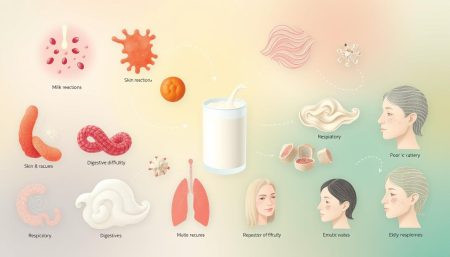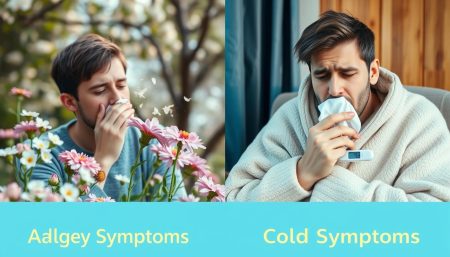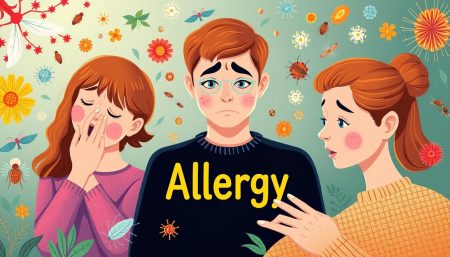Understanding the first signs of a seafood allergy is key to quick action. As food allergies grow worldwide, knowing these signs is crucial. Symptoms can range from mild to severe, showing the body’s reaction to certain proteins in fish and shellfish.
Spotting the early signs, like digestive issues or a rash, is vital. It’s like following the ripples back to the pond’s center. Knowing these signs helps protect your health. Seafood allergies cause a range of physical reactions, so being informed is the first step to safety.
Key Takeaways
- Identifying seafood allergy symptoms promptly can prevent life-threatening reactions.
- Recognizing the signs of seafood allergy provides critical insight for those at risk.
- Seafood allergy rash is a common manifestation of allergic reactions to seafood.
- Awareness and knowledge about seafood allergies are crucial in managing the condition effectively.
- It is important to differentiate between a mild allergic response and severe reactions such as anaphylaxis.
Understanding Seafood Allergy
Seafood allergies are becoming more common, affecting both kids and adults. They can cause a range of symptoms, some of which are quite severe. These allergies usually target proteins in seafood, which includes fish and shellfish.
What Is a Seafood Allergy?
A seafood allergy happens when the body sees proteins in fish and shellfish as threats. This leads to fish allergy symptoms and shellfish allergy symptoms. These symptoms can really affect a person’s health and daily life.
The Difference Between Fish and Shellfish Allergies
Fish and shellfish allergies are different. You might be allergic to one but not the other. Fish allergies often involve species like salmon and tuna. Shellfish allergies, especially crustaceans like shrimp, can cause severe reactions.
Common Seafood Allergy Causes
There are many reasons why someone might develop a seafood allergy. Genetics and environmental factors play a role. Being exposed to seafood proteins can make you allergic to them, leading to reactions later on.
The table below shows which seafood types are more likely to cause allergies. It helps you understand which seafood might be safe and which might not.
| Seafood Type | High Allergy Risk | Low Allergy Risk |
|---|---|---|
| Shrimp | Yes | No |
| Salmon | No | Yes |
| Oysters | Yes | No |
| Tilapia | No | Yes |
This information helps you make better choices about what seafood to eat. It can help you avoid foods that might trigger an allergic reaction.
Identifying Seafood Allergy Symptoms
It’s important to know the signs of seafood allergy to manage them well. The symptoms of allergic reactions to seafood can range from mild to severe. It’s key to recognize these signs, as they can be mistaken for other health issues.
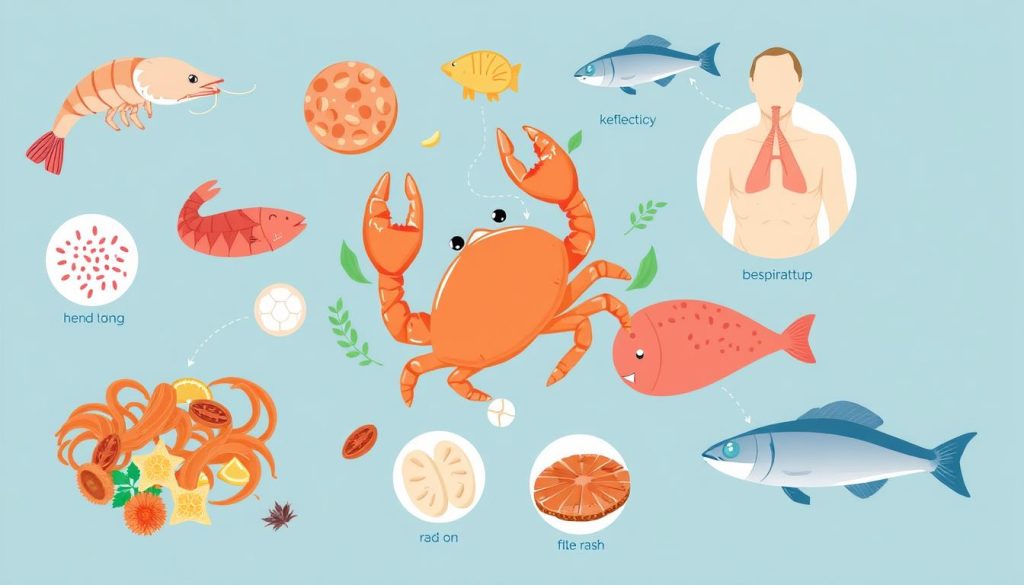
- Itching or hives, which may appear within minutes to several hours after consuming seafood.
- Swelling of the lips, face, tongue, throat, or other parts of the body.
- Wheezing, nasal congestion, or trouble breathing.
- Abdominal pain, diarrhea, nausea, or vomiting.
- Dizziness, lightheadedness, or fainting.
How people react to seafood can differ. Some might have many symptoms, while others might only notice one. If you think you’re having a severe reaction, get help right away. Severe reactions can turn into anaphylaxis quickly.
Knowing the signs of seafood allergy helps you get the right medical help fast. If you think you have a seafood allergy, see a doctor. They can give you a proper diagnosis and a plan to manage your allergy.
Immediate Signs of Seafood Allergy
For many, eating seafood can cause a quick and serious allergic reaction. It’s key to spot immediate seafood allergy symptoms fast. This is especially true for anaphylaxis, a serious condition that can be life-threatening.
Physical Reactions to Seafood Exposure
Right after eating seafood, symptoms can range from hives to severe itching. These signs often show up on the face, lips, tongue, and throat. They can make it hard to breathe or swallow, showing how fast the body reacts to allergens.
Anaphylaxis: A Severe Allergic Response
Anaphylaxis is a serious sign of a seafood allergy. It affects the skin, airways, and heart, causing blood pressure to drop. This can lead to fainting or dizziness. It’s crucial to act fast when anaphylaxis happens.
| Symptom | Time of Onset | Severity |
|---|---|---|
| Hives | Minutes | Moderate |
| Swelling | Minutes to Hours | Moderate to Severe |
| Anaphylaxis | Minutes | Severe |
| Difficulty Breathing | Minutes to Hours | Moderate to Severe |
Knowing about immediate seafood allergy symptoms and anaphylaxis is crucial. Being ready to act fast can save lives. It’s important to have things like epinephrine injectors on hand for severe reactions.
Spotting a Seafood Allergy Rash
Knowing how to spot a seafood allergy rash is key for those with seafood allergy symptoms. This rash, known as urticaria, shows up as raised, red, and itchy welts on the skin. It often pops up right after eating seafood and can change in size and shape.
This rash is different from others, like those from viruses or environmental irritants. A seafood allergy rash comes with other signs that show an allergic reaction.

Studies show that a seafood allergy rash usually hits the face, neck, hands, and chest. These areas are more likely to react to allergens. Unlike eczema, which can look similar, seafood allergy rashes come on fast and are more severe.
Knowing the difference can lead to quick medical help and better symptom management.
| Feature | Seafood Allergy Rash | Other Common Rashes |
|---|---|---|
| Appearance | Red, raised welts | Flat, red patches |
| Texture | Smooth with clear edges | May be scaly or irregular |
| Speed of Onset | Minutes to hours | May develop over days |
| Accompanied Symptoms | Itching, swelling, difficulty breathing | Usually localized discomfort |
If you get a seafood allergy rash, taking antihistamines or corticosteroids can help. But, always follow your doctor’s advice. Knowing about these rashes can help you act fast and avoid worse seafood allergy symptoms.
Seafood Intolerance vs. Seafood Allergy
It’s important to know the difference between seafood intolerance and allergy. Seafood allergy symptoms involve the immune system. On the other hand, seafood intolerance symptoms are about digestive issues. This section will help you understand these differences to get the right treatment.
Understanding Seafood Intolerance Symptoms
Seafood intolerance mainly affects your digestive system. It causes discomfort but doesn’t trigger an immune response. Symptoms include bloating, gas, cramps, and diarrhea after eating seafood.
These symptoms can be mild or severe. They often show up hours after eating seafood. This makes it hard to know you have an intolerance at first.
Distinguishing Between Allergy and Intolerance
A seafood allergy is different. It can cause serious, even life-threatening reactions. It involves the immune system.
Symptoms can be hives, swelling, trouble breathing, or even anaphylaxis. If you have these symptoms, you need to see a doctor right away.
| Condition | System Affected | Symptoms | Onset Time |
|---|---|---|---|
| Seafood Allergy | Immune | Hives, Swelling, Anaphylaxis | Minutes to Hours |
| Seafood Intolerance | Digestive | Bloating, Gas, Diarrhea | Hours to Days |
Knowing the difference helps you manage your health better. By avoiding triggers and getting the right treatment, you can feel better. It’s key to figure out if your symptoms are from intolerance or allergy.
Digestive Symptoms of Seafood Allergy
People with seafood allergies often notice digestive symptoms. These signs are key to spotting the allergy early. Spotting them quickly helps manage the reaction and get medical help fast.
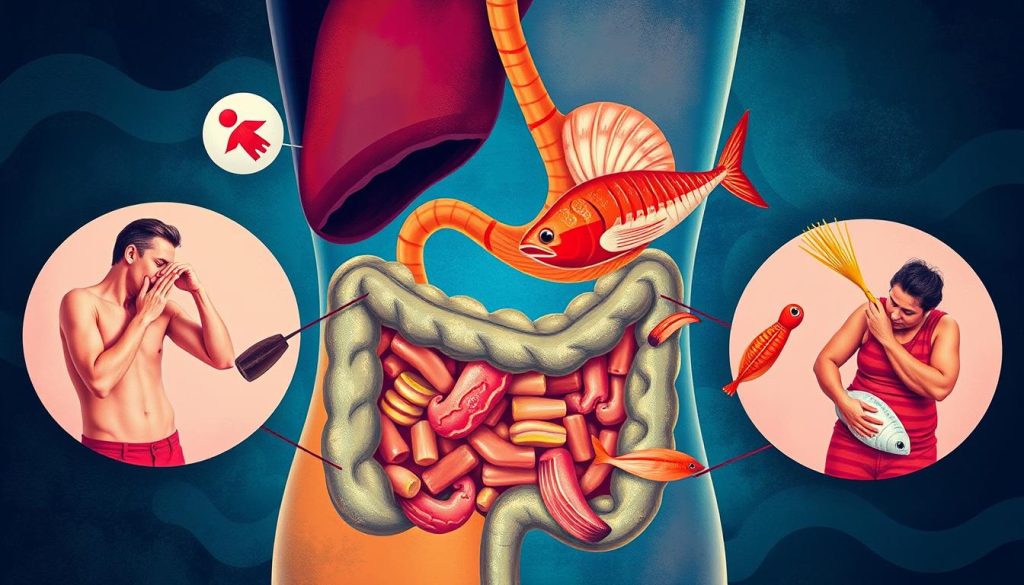
The stomach can react badly to seafood allergens. Symptoms like nausea, vomiting, and diarrhea are common. They can start within minutes to hours after eating seafood. Knowing these symptoms helps react quickly to allergic reactions.
| Symptom | Time to Onset | Possible Severity |
|---|---|---|
| Nausea | Minutes to 1 hour | Mild to moderate |
| Vomiting | 30 minutes to 2 hours | Moderate to severe |
| Diarrhea | 1 to 4 hours | Moderate to severe |
Abdominal pain and bloating can also happen. These add to the discomfort. Many people see a doctor for advice and treatment.
Experts say anyone with these symptoms after eating seafood should see a doctor. This is especially true if symptoms happen with different seafood types. It means they might have a seafood allergy, not just a problem with one type of fish or shellfish.
In short, knowing the digestive signs of seafood allergy helps manage it well. This reduces the risk of serious allergic reactions and improves health.
Respiratory and Cardiovascular Symptoms
People with seafood allergies can face many symptoms. These can affect the lungs and heart. These reactions can be serious and need quick help.
Respiratory Issues from Seafood Allergens
Seafood allergies can cause breathing problems. Symptoms include trouble breathing, wheezing, and coughing. These can get worse fast, leading to asthma or anaphylaxis. It’s important to watch for these signs and act quickly.
Cardiovascular Signs of Seafood Allergy
Seafood allergies can also affect the heart. Signs include heart racing, low blood pressure, and dizziness. These are serious signs that need immediate medical care. The heart’s reaction to allergens shows how severe the allergy is.
- Shortness of breath or wheezing immediately after consuming seafood.
- Heart palpitations or a feeling of the heart racing during an allergic episode.
- Dizziness or a drop in blood pressure, which can lead to fainting.
Many people share stories of how fast these seafood allergy symptoms can appear. Being aware and prepared is key for those at risk.
The Onset of Seafood Allergy in Adults
Many adults find it puzzling to develop a seafood allergy later in life. Unlike allergies in children, adult onset seafood allergy is different. It brings unique challenges in diagnosis and management. Knowing about fish allergy symptoms in adults is key to managing and preventing it.
Developing Seafood Allergy Later in Life
Some people who have eaten seafood without problems suddenly face allergic reactions. These reactions can range from mild itching to severe anaphylactic shocks. It’s important to understand the symptoms of fish allergy in adults.
The reasons for developing an adult onset seafood allergy are still being studied. But, a sudden change in how the immune system reacts to seafood proteins is a big factor. This can happen due to changes in health, like hormonal imbalances or diseases that affect the immune system.
Factors Contributing to Adult-Onset Allergies
Studies have found several reasons for seafood allergies in adults. A weakened immune system, interactions with other allergens, and environmental factors like pollution are possible causes. It’s crucial for adults with unexpected allergy symptoms to consider these factors.
An adult onset seafood allergy can be easily missed since symptoms might seem like other issues. This highlights the need for awareness and accurate symptom recognition. With the right approach and care, managing this condition is possible.

Pediatric Concerns: Fish Allergy Symptoms in Children
For many parents, understanding pediatric seafood allergy and spotting fish allergy symptoms in children is key. It helps keep their child safe and healthy. Early detection and smart management can really help.
Children show unique signs of a seafood allergy. These signs include skin issues like hives or eczema, stomach problems like vomiting or diarrhea, breathing troubles, and in serious cases, anaphylaxis. Spotting these symptoms early can lead to quicker, better help.
- Hives or rash
- Swelling of the lips, tongue, or face
- Difficulty breathing or wheezing
- Gastrointestinal distress
- Anaphylaxis in extreme cases
It’s important to recognize these signs and understand their cause. Talking to a healthcare professional is a good first step. For more info on pediatric allergies, check out this resource.
Managing a pediatric seafood allergy is more than just avoiding allergens. It’s also about teaching others about the allergy, reading food labels carefully, and having a plan for emergencies.
| Age Group | Common Symptoms | Suggested Actions |
|---|---|---|
| Toddlers | Rashes, mild swelling | Monitor diet closely, seek pediatric advice |
| School-aged Children | Breathing difficulty, gastrointestinal issues | Educate on allergen avoidance, prepare emergency plan |
| Teens | Anaphylaxis potential | Self-carry epinephrine, allergy awareness training |
Sharing stories from other families with fish allergy symptoms in children can offer support and useful tips. Support groups and online forums are great for emotional support and practical advice.
Learning about pediatric seafood allergy and being proactive can help a lot. With the right knowledge and steps, parents can make a safe space for their kids.
Seafood Allergy Symptoms in Specific Populations
Seafood allergies are becoming more common. It’s important to know how they affect different groups. This includes pregnant women and the elderly, who face unique challenges.
Risks for Pregnant Women and Seafood Allergies
Pregnant women have a lot to worry about when it comes to seafood allergies. Seafood is full of nutrients like omega-3 fatty acids that are good for the baby. But, it can also be risky for them.
The immune system changes during pregnancy. This can make a woman’s reaction to allergens worse. It’s crucial for pregnant women to talk to their doctors about safe eating.
Elderly Individuals and Heightened Sensitivity
The elderly may be more sensitive to seafood allergies. As people age, their immune system gets weaker. This makes them more likely to have severe reactions.
Older adults often have other health problems too. This makes managing allergies even harder. They need to watch their diet closely to avoid bad reactions.

Knowing how seafood allergies affect certain groups helps improve their care. Pregnant women and the elderly need special attention. They should get tested and get advice from experts to stay safe and healthy.
Risk Factors and Genetic Predisposition
Looking into the genetic roots and risk factors of seafood allergies helps us understand the mix of genes and environment. Knowing this is key to helping and preventing allergies in those at risk.
Family History and Seafood Allergy Risks
Studies show family history is a big clue in seafood allergies, pointing to seafood allergy genetic factors. Families with allergy history, especially to seafood, often share these sensitivities. This shows how genes can affect how our immune system reacts to allergens.
Understanding Cross-Reactivity with Other Allergens
Cross-reactivity happens when proteins in different things, like pollens or foods, trigger an immune response in people sensitive to similar allergens. This cross-reactivity makes diagnosing and treating seafood allergies harder.
| Seafood Allergen | Common Cross-Reactive Allergens |
|---|---|
| Shrimp | House dust mites |
| Crab | Tropomyosin in other shellfish |
| Lobster | Cockroaches and certain insects |
This table shows how cross-reactivity allergens are key in seafood allergy reactions.
Diagnosing Seafood Allergy
Understanding seafood allergy diagnosis is key for those with possible allergic reactions. It confirms the allergy and helps manage symptoms well.
Allergy Testing for Seafood Reactions
The first step is allergy testing for seafood. Skin prick tests and IgE blood tests are common. They are accurate and crucial for diagnosing seafood allergies.
Interpreting Test Results and Next Steps
Reading test results carefully is important. Positive results suggest a seafood allergy. But, a doctor must also look at your medical history and symptoms.
Doctors will talk to you about these results. They’ll tell you what foods are safe and what to do in case of an emergency.
| Test Type | Description | Relevance to Seafood Allergy Diagnosis |
|---|---|---|
| Skin Prick Test | Small amount of allergen placed on the skin; observed for reactions. | Quick and effective for identifying potential seafood allergies. |
| Specific IgE Blood Test | Measures the level of IgE antibodies to specific allergens in blood. | Useful for confirming allergy when skin tests are inconclusive or cannot be performed. |
| Component Resolved Diagnostics | Identifies specific allergen components causing the reaction. | Helps in understanding specific seafood proteins causing allergies, aiding in targeted management. |
After a diagnosis, you might need to avoid certain foods. You’ll also get an emergency plan and possibly desensitization therapy. This depends on how severe your allergy is and your personal situation.
Managing Seafood Allergy Symptoms
Managing a seafood allergy requires a plan that fits your health and surroundings. It’s key for those with this allergy to stick to prevention strategies. They should also know how to treat any accidental exposure.
- Educational Commitment: Learn about seafood products in foods. Always check labels, as ingredients can change.
- Communication: Tell your loved ones and food handlers about your allergy. This helps prevent cross-contamination and ensures safe food choices.
- Avoidance: Avoid places like fish markets and seafood restaurants. Even grocery stores’ seafood aisles can be risky.
Seafood allergy treatment is crucial too. Carry an epinephrine auto-injector and have a plan for emergencies.
Always have a treatment plan ready, collaborate with your healthcare provider to tailor this plan specifically for you.
Making lifestyle changes, like careful meal planning, can help. Joining allergy support groups offers practical advice and emotional support.
By knowing what to do and taking preventive steps, you can manage your seafood allergy well. This reduces the chance of serious reactions and helps you live a safe, happy life.
Emergency Response: Seafood Allergy Treatment
When a seafood allergy reaction happens, knowing what to do is key. It’s important to understand the first steps and when to get emergency help. This part will cover how to handle these situations well.
First-Aid for Seafood Allergy Reactions
Quick action can lessen the impact of a seafood allergy reaction. Here are the main steps to follow:
- Stop eating right away if you think you’re having a reaction.
- Take an antihistamine as soon as symptoms show up, if you can swallow it.
- Use an epinephrine auto-injector if symptoms get worse fast or if you can’t breathe.
- Call for emergency medical help right after using epinephrine.
- Keep the person calm and lying down, to prevent choking.
- Watch their breathing and if they’re awake until help gets there.
When to Seek Emergency Medical Attention
Knowing when to call for emergency help is very important. Here are signs that mean you should get medical help right away:
- Signs of anaphylaxis, like trouble breathing, swelling, and feeling dizzy.
- Staying symptoms even after taking antihistamines and/or epinephrine.
- If you’re unsure about how serious the reaction is, it’s best to get medical help.
Protecting against serious seafood allergy problems depends on quick, smart actions. Knowing when to use important medicines like epinephrine is crucial. Each step is important for effective first-aid for seafood allergies.
Living with a Seafood Allergy
Living with a seafood allergy means you need to be very careful. You must avoid seafood at all costs. This includes being careful in the kitchen and when eating out.
Coping Strategies and Lifestyle Adjustments
Managing a seafood allergy requires big changes in your life. You need to learn how to read food labels and tell others about your allergy. It’s also important to handle food safely to prevent cross-contamination.
Having a plan for emergencies is key. This plan should include knowing where to find antihistamines and epinephrine auto-injectors.
- Educate yourself and others about your allergy.
- Keep emergency contact information and medications accessible at all times.
- Join support groups to connect with others who share similar challenges.
Navigating Dining Out and Avoiding Triggers
Eating out can be hard for those with seafood allergies. It’s important to pick restaurants that are safe and tell the staff about your allergy. Many places now offer special menus or cook food separately to avoid cross-contamination.
| Tips for Dining Out | How to Implement |
|---|---|
| Research restaurants beforehand | Call ahead to discuss menu options and kitchen practices |
| Be clear about your allergy | Inform every server or chef about the severity of your allergy |
| Double-check your order | Confirm that your meal is seafood-free before eating |
By following these tips, managing a seafood allergy becomes easier. You can live a full life without worrying about seafood. Just remember to stay alert and informed about your allergy.
Seafood Allergy Myths and Misconceptions
It’s important to clear up myths about seafood allergies. Many people believe things that aren’t true. We’ll look at the real facts about seafood allergies.
One common myth is that all seafood causes allergic reactions, which is not true. Seafood allergies are usually specific to shellfish or finned fish, not all seafood. Another myth is that if you’re allergic to one seafood, you must avoid all others. This isn’t always true.
- Shellfish and fish are different allergens.
- Individuals may only be allergic to one category.
- Testing can identify specific seafood allergies.
Some people think you can outgrow a seafood allergy, like some other allergies. But this is rare. Seafood allergies often last a lifetime. This shows why getting a correct diagnosis and managing it for life is key.
| Myth | Fact |
|---|---|
| Allergic to one, allergic to all seafood | Many can tolerate other types of seafood not related to their allergen. |
| Seafood allergies can be outgrown | These allergies are usually lifelong. |
| Immediate reaction means severe allergy | Severity of allergies varies widely; an allergist should assess risk. |
Another misconception is that iodine or drinking alcohol with seafood causes allergies. This is not true. Seafood reactions are due to proteins like tropomyosin, not iodine. Alcohol doesn’t trigger these reactions. But, mixing alcohol and seafood can hide the start of an allergic reaction, making it harder to diagnose yourself.
“Understanding the difference between actual seafood allergy symptoms and myths can significantly reduce both undue anxiety and the risk of a real medical emergency.”
Clearing up seafood allergy myths with seafood allergy facts helps manage the disease better. It also reduces unnecessary dietary restrictions. These restrictions can affect your nutrition and quality of life.
Conclusion
Understanding and managing seafood intolerance has been a journey of discovery and empathy. We’ve explored the complexities of recognizing symptoms that go beyond mere discomfort. We’ve seen how seafood allergy affects people’s lives.
We’ve learned the difference between allergy and intolerance. We’ve also learned the immediate steps needed in an emergency. Our insights highlight the critical need for seafood allergy awareness.
During our exploration, we’ve found an important reminder. Those affected are not alone. There are resources available, like detailed explanations on allergic and toxic reactions to seafood. These resources help make informed choices and ensure safer living.
For those who are health-conscious or coping with cancer, accurate diagnosis and tailored management plans are crucial. They offer a sense of control in uncertain times.
Lives touched by seafood allergies need compassion and support. As we conclude, we want to reassure everyone. Through ongoing education and advocacy, the well-being of sufferers can improve greatly. We aim to make complex medical terms easier to understand. This way, we hope to help those dealing with seafood intolerances and allergies find resilience and autonomy.
FAQ
Q: What are some common symptoms of a seafood allergy?
A: Symptoms include hives, itching, and swelling of the lips or face. You might also have trouble breathing, stomach pain, or nausea. In severe cases, anaphylaxis can occur. These reactions can happen within minutes to hours after eating seafood.
Q: Can you suddenly develop a seafood allergy as an adult?
A: Yes, adults can develop a seafood allergy even if they’ve eaten seafood before without issues. Changes in the immune system or new exposure to allergens in seafood can trigger it.
Q: How can I differentiate between seafood allergy and intolerance?
A: Seafood allergy triggers an immune reaction, causing symptoms like hives and swelling. Intolerance affects digestion, leading to stomach pain and diarrhea without an immune response.
Q: Is it necessary to avoid all types of seafood if I have a fish allergy?
A: Not always. Some people can tolerate certain fish or shellfish even if allergic to others. But, to avoid cross-contamination and reactions, it’s wise to avoid all seafood unless a specialist advises otherwise.
Q: What should I do if I experience a severe allergic reaction to seafood?
A: If you have a severe reaction, like trouble breathing or a drop in blood pressure, use an epinephrine auto-injector if you have one. Then, get emergency medical help right away.
Q: How are seafood allergies diagnosed?
A: Diagnosing seafood allergies involves a patient history, food diary, and tests like skin prick tests and blood tests. Sometimes, an oral food challenge under medical supervision is needed.
Q: Can I prevent my child from developing a seafood allergy?
A: There’s no guaranteed way to prevent seafood allergies. But, early and regular exposure to different foods, including seafood, might help some children. Talk to a pediatrician for advice.
Q: Are pregnant women at greater risk for developing seafood allergies?
A: There’s no clear evidence that pregnant women are more likely to get seafood allergies. But, those with allergies should be careful and talk to their healthcare provider about safe foods.
Q: Can a seafood allergy go away over time?
A: Food allergies can sometimes go away, but it’s less common with seafood allergies, especially in adults. Regular check-ups with an allergy specialist can help see if the allergy has changed.
Q: What treatment options are available for managing seafood allergies?
A: Treatment mainly involves avoiding seafood and being ready to treat reactions. Use antihistamines for mild reactions or epinephrine for severe ones. Work with an allergist to create a personalized plan.













